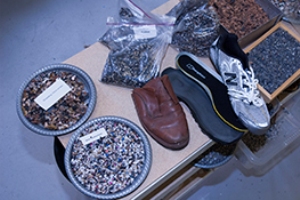Oct 18 2013
A newly developed recycling process could make landfill sites filled with old shoes a thing of the past.
 Shows shoe components and fragments resulting from different stages of the recycling process
Shows shoe components and fragments resulting from different stages of the recycling process
The world’s first comprehensive system for separating and recovering useful materials from old footwear has been successfully trialled.
It is able to granulate and segregate leather, plastic foams and rubber so that they can be re-used in products ranging from rubber playground surfacing to new shoes!
The system was developed and tested at Loughborough University’s Innovative Manufacturing and Construction Research Centre (IMCRC), whose ten year research programme was funded by the Engineering and Physical Sciences Research Council (EPSRC).
You can find out more about the research in an audio slide show on the EPSRC YouTube channel. (NB the full link address is https://www.youtube.com/watch?v=uAH0K7porxw. The title of the audio slide show is Shoe recycling gets a kick-start.
“Footwear is incredibly difficult to recycle as it can contain up to forty different types of material, many of which are stitched or glued together,” says Professor Shahin Rahimifard, who led the project. “In our process, the first, manual step is to pre-sort shoes into broad types, such as trainers, and to recover metals, such as eyelets. Next the shoes are automatically shredded and granulated, with the granules automatically separated into four waste streams: leather, foams, rubber and other material.”
The shoes are turned into 3-4mm fragments using a granulator. Low-cost air-based technologies developed by the project then separate the materials by exploiting their different sizes and weights: an air-cascade separator first removes lighter textile particles and other fine leather and foam residues by blowing them away from heavier granules; then a series of vibrating air-tables separate rubber from foam and leather by stratifying the granulated materials, with lighter granules ending up on top of heavier ones.
For each recovered material stream, there are a variety of applications. For example:
- Recovered leather fibres can be reformed to produce bonded leather sheets
- Reclaimed rubber can be used as a running track or playground surfacing product
- For some types of footwear rubbers, finely ground rubber can be put back into new shoe soles – achieving so-called ‘closed loop’ recycling.
- Recycled foams can be used in underlay material for laminate floors and carpets
- A key use for mixed textiles and other lighter residues could be as insulation material for buildings
The Loughborough team is now talking to a recycling company interested in incorporating the process into its operations. In parallel, with EPSRC funding, collaboration is also under way with major footwear manufacturers to explore how shoes could be designed differently in future to make them easier to recycle.
The team has already developed a computerised tool that advises footwear designers on materials selection and helps them explore whether particular combinations of materials would make recycling harder or easier. The more similar two materials are in density, the harder it is to separate granules made of them, driving up the cost of recycling.
“Our ultimate goal is to build on all our EPSRC-funded work and develop follow-up lines of research that stimulate industry interest, and for our future projects to become self-funding,” says Professor Rahimifard. “But we believe we’ve already helped footwear recycling perhaps take the first step towards becoming as economically feasible as glass, plastic or paper recycling.”
The breakthrough could lead to enormous environmental benefits – currently 95 per cent of the 20 billion pairs of shoes produced globally each year end up in landfill sites. To date the only way of avoiding the landfilling of unwanted shoes has been to deposit them in ‘shoe banks’ for second-hand use.
For more information on this project, visit www.centreforsmart.co.uk